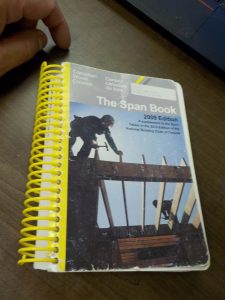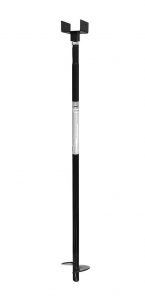
This image shows one of the things our building inspectors are trained to spot. This pipe is a vent pipe – known to some as a “stink pipe,” in a renovation.
And it also created a violation of the National Building Code in the process.
Why?
Buildings these days are complicated things, and now more than ever, sub-contractors are faced with challenges about how to route things like water pipes, waste pipes, electrical wiring, communications and alarm wiring and the like through joists and walls.
Here’s the general rule on how to drill holes through studs or joists: Never drill a hole more than 1/4 of the thickness of the load-bearing member, and never drill a hole so that its edge is closer to 50 mm of the edge of that section of wood.
Load-bearing studs have more strict regulations, according to clause 9.23.5.3 of our inspector’s favourite bedtime storybook, the National Building Code of Canada, 2010 edition:
Wall studs shall not be notched, drilled or otherwise damaged so that the undamaged portion of the stud is less than two-thirds the depth of the stud if the stud is loadbearing or 40 mm if the stud is non-loadbearing, unless the weakened studs are suitably reinforced.
That’s what happened here: the pipe cuts through a load-bearing stud and is larger than 1/3 of the stud width. The hole was actually 2 1’2” wide, in a 5 1/2” wide 2x6 stud.
Fortunately, our inspectors aren’t just trained to find problems: they’re also able to – at least in situations like this – provide solutions. Our staff asked the framing contractor to install a 2x4 on the inside edge of the damaged stud from floor to ceiling to create a supplemental load-bearing element: but it could have been worse.
The big no-no: do not damage engineered trusses or open-web joists. If this is done, we will require the builder to obtain detailed repair instructions from the truss/joist manufacturer, which can cause delays in construction.
Here’s the entire “notching and framing” section of NBC 2010, for those inclined to study such things.
9.23.5.1. Holes Drilled in Framing Members
1) Holes drilled in roof, floor or ceiling framing members shall be not larger than
one-quarter the depth of the member and shall be located not less than 50 mm from the edges, unless the depth of the member is increased by the size of the hole.
9.23.5.2. Notching of Framing Members
1) Floor, roof and ceiling framing members are permitted to be notched provided
the notch is located on the top of the member within half the joist depth from the edge of bearing and is not deeper than one-third the joist depth, unless the depth of the
member is increased by the size of the notch.
9.23.5.3. Wall Studs
1) Wall studs shall not be notched, drilled or otherwise damaged so that the
undamaged portion of the stud is less than two-thirds the depth of the stud if the
stud is loadbearing or 40 mm if the stud is non-loadbearing, unless the weakened studs are suitably reinforced.
9.23.5.4. Top Plates
1) Top plates in walls shall not be notched, drilled or otherwise weakened to
reduce the undamaged width to less than 50 mm unless the weakened plates are suitably reinforced.
9.23.5.5. Roof Trusses
1) Roof truss members shall not be notched, drilled or otherwise weakened unless
such notching or drilling is allowed for in the design of the truss.







